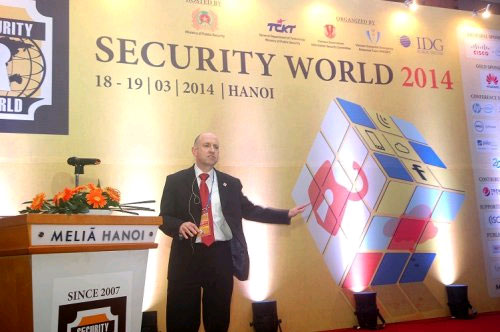Hội thảo về An ninh Bảo mật 2014 (Security World 2014) với chủ đề “Gắn kết chiến lược an toàn thông tin với các mục tiêu tăng trưởng và phát triển” do Tập đoàn Dữ liệu Quốc tế IDG, Tổng cục Hậu cần Kỹ thuật (Bộ Công an), Ban Cơ yếu Chính phủ (Bộ Quốc phòng), VNCERT và Hiệp hội Internet Việt Nam (VIA) vừa được tổ chức tại Hà Nội.
Tại Hội thảo này, Huawei đã chia sẻ về chiến lược An ninh mạng (cyber security) “tích hợp”.
Trong Báo cáo chính tại Hội thảo với tiêu đề “Xây dựng văn hóa Bảo Mật: Tích hợp bảo mật thông tin trong hoạt động của doanh nghiệp”, ông David Francis, Giám đốc Bảo mật Mạng của Huawei tại Vương quốc Anh nhận xét rằng sự phát triển của các hệ thống mạng đã kết nối thế giới, mở rộng cơ hội giao thương giữa các khu vực và phát triển thương mại toàn cầu, thúc đẩy tiến bộ xã hội.
Các hệ thống mạng mở đã khuyến khích chia sẻ và trao đổi thông tin, cung cấp nhiều cơ hội hơn cũng như giảm các chi phí sáng tạo, giúp thúc đẩy sự phát triển và thịnh vượng của thế giới. Tuy nhiên, đẩy mạnh ứng dụng ICT cũng tạo ra những mối đe dọa mới gây mất an toàn, an ninh mạng.
Ông David Francis, Giám đốc Bảo mật Mạng của Huawei tại Vương quốc Anh trình bày tại Hội thảo
“Với an ninh mạng, các mối đe dọa đang thay đổi, các hình thức tấn công mạng đang thay đổi và mục tiêu của các cuộc tấn công cũng đang thay đổi, từ chính trị đến chủ nghĩa bảo hộ, từ tiền bạc đến tin tặc. Các mối đe dọa bảo mật mạng không bao giờ ngừng, vì thế chúng ta cũng không bao giờ được phép ngừng lại”, ông Davidnói.
Theo ông David Francis, an ninh mạng không phải là vấn đề của riêng một quốc gia hay một doanh nghiệp nào. Tất cả các bên liên quan, như các cơ quan chính phủ và cả ngành công nghiệp, cần nhận thức rằng an ninh mạng là một vấn đề chung của toàn cầu và cần những phương thức tiếp cận trên cơ sở rủi ro, chia sẻ những kinh nghiệm thực tiễn tốt nhất và hợp tác quốc tế để cùng giải quyết thách thức.
Cũng trong bài trình bày của mình, ông David Francis cho biết Chiến lược an ninh mạng tích hợp bao gồm các yếu tố sau:
Chiến lược, quản trị và kiểm soát: Cần có một chiến lược tổng thể và trách nhiệm giải trình những gì xảy ra;
Các tiêu chuẩn và quy trình: Sử dụng các tiêu chuẩn tốt nhất và các phương pháp luận để bảo vệ trước các mối đe dọa và rủi ro;
Luật và các quy định: Giúp các sản phẩm và hoạt động của công ty tuân thủ pháp luật tại mọi quốc gia nơi công ty hoạt động;
Nguồn nhân lực: Sử dụng đúng người, đúng vị trí và với cách hành xử phù hợp để giới hạn các vấn đề trong vòng kiểm soát;
Nghiên cứu và phát triển: Thiết kế, xây dựng, kiểm định các sản phẩm theo một cách thức bảo mật chặt chẽ;
Kiểm tra – Không giả định, không tin ai, kiểm tra mọi thứ: Nhiều mắt, nhiều tay và nhiều cách kiểm tra. Cách tiếp cận độc lập theo lớp để kiểm tra bảo mật;
Quản lý nhà cung cấp thứ ba: Đặt các nhà cung cấp thứ ba trong khả năng bảo mật nghiêm ngặt.
Sản xuất: Sản xuất các sản phẩm bảo mật theo từng bước, cho đến khi cung cấp ra thị trường;
Cung cấp các dịch vụ một cách an toàn: Bảo đảm việc cài đặt, dịch vụ và hỗ trợ được bảo mật. Không thể giả mạo, kiểm toán đầy đủ;
Khi gặp sự cố – vấn đề, lỗ hổng và giải pháp khắc phục: Khi các vấn đề bảo mật phát sinh, cần giải quyết chúng một cách nhanh chóng và bảo đảm công nghệ của khách hàng được an toàn;
Kiểm toán: Sử dụng cơ chế kiểm toán chặt chẽ để bảo đảm mọi bộ phận phù hợp với chiến lược.
ictpress.vn









